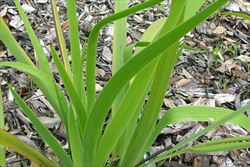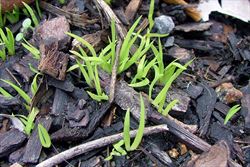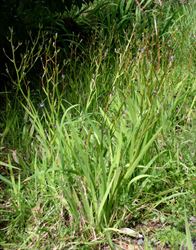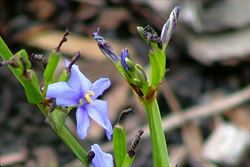Click on images to enlarge

habit (Photo: Sheldon Navie)

habit in flower (Photo: Sheldon Navie)

stems and leaves (Photo: Sheldon Navie)

flower clusters (Photo: Sheldon Navie)

close-up of flower (Photo: Sheldon Navie)

close-up of immature fruit (Photo: Sheldon Navie)

mature fruit releasing their seeds (Photo: Sheldon Navie)

seedlings (Photo: Sheldon Navie)

infestation in bushland (Photo: Trevor James)

close-up of leaves (Photo: Sheldon Navie)

old flowers, with twisted petals, and young fruit (Photo: Sheldon Navie)

close-up of immature fruit (Photo: Trevor James)

mass germination of seedlings near parent plant (Photo: Sheldon Navie)
Scientific Name
Aristea ecklonii Baker
Family
Iridaceae
Common Names
African blue star iris, aristea, blue corn lily, blue corn-lily, blue eyed iris, blue-eyed iris, blue eyes, blue flies, blue iris, blue stars, blue stars lily
Origin
Native to western and southern Africa (i.e. Uganda, Burundi, Cameroon, Rwanda, southern Zaire, Mozambique, Tanzania, Zimbabwe, South Africa and Swaziland).
Naturalised Distribution
This species has recently become naturalised in some parts of south-eastern Australia (i.e. in the coastal districts of central New South Wales and in southern Victoria). It has also been reported from the coastal districts of southern New South Wales and very recently from Springbrook in south-eastern Queensland.
Notes
This commonly grown garden plant is regarded as an environmental weed in Victoria and New South Wales and as a potential environmental weed or "sleeper weed" in other parts of southern and eastern Australia. In its natural habitat, in southern Africa, it grows in a variety of habitats from streambanks and forest margins to grasslands and shrublands.
Blue stars (Aristea ecklonii) has escaped cultivation in Australia, and is an emerging weed of roadsides, waterways (i.e. riparian vegetation), disturbed bushland and open woodlands near urban areas (particularly around Melbourne and Sydney). In Victoria it is considered to pose a threat to riparian vegetation and dry sclerophyll woodlands and on the central coast of New South Wales it is a weed of disturbed woodlands. Blue stars (Aristea ecklonii) has also been reported to be growing in conservation areas in New South Wales (e.g. in the O’Hara Head Reserve at Kioloa in the Shoalhaven region and the the Cooyong Road Reserve in Warringah in suburban Sydney) and was also recently collected growing in a conservation area at Springbrook in south-eastern Queensland.

